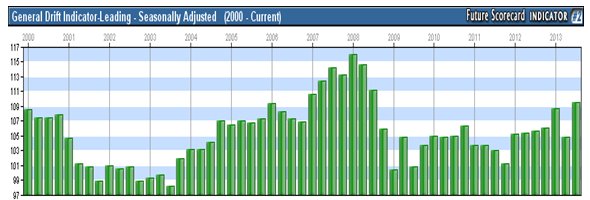Comptroller Kevin Lembo Archive > News
COMPTROLLER LEMBO PROJECTS $504.9-MILLION SURPLUS FOR FISCAL YEAR 2014Comptroller Kevin Lembo today announced that the state is currently on track to end Fiscal Year 2014 with a $504.9-million surplus - a number that could grow following this month's revenue collection, barring any last-quarter spending increases.
In a letter to Gov. Dannel P. Malloy, Lembo said he agrees with the Office of Policy and Management's (OPM) latest projection, which is a slight increase of approximately $500,000 from last month's estimate.
Lembo said April is a significant month for revenue collection - accounting for almost 17 percent of total General Fund revenue realized last fiscal year.
"If these trends carry into the last quarter of this fiscal year without offsetting spending increases, the current General Fund surplus projection would be expected to grow," Lembo said. "All major revenue categories are exceeding or are close to original budget estimates."
Total General Fund revenue for 2014 is expected to exceed initial budget targets by $421.2 million. The three largest tax categories, which are income, sales and corporations, are all exceeding initial budget expectations, Lembo said. The largest gain, $213.1 million, is in the income tax. The stock market gains have fueled estimated income tax payments.
Spending projections -- budgeted to grow 3.8 percent this fiscal year - still remain below initial budget targets, Lembo said.
While the outlook for the current fiscal year continues to improve, Lembo said the state faces financial challenges in the outlying years. Lembo reemphasized the critical importance of directly depositing any additional surplus in excess of this month's estimate into the Budget Reserve Fund to account for future shortfalls.
The reserve balance at the end of Fiscal Year 2013 was $270.7 million. This represents 1.6 percent of net appropriations. If the legislature enacts Governor Malloy's plan to allocate the current estimated surplus and $30 million reserve for Fiscal Year 2015, an additional $279.9 million would be deposited to the Budget Reserve Fund, bringing the balance to $550.6 million or just over 3 percent of planned spending.
"I have advocated for a reserve level of 15 percent of spending," Lembo said. "Sufficient dollars in reserve will guard against future tax increases and service reductions during inevitable future recessionary cycles.
"As the disposition of the surplus is debated, policy makers should remember that the Fiscal Year 2014 General Fund budget relies on $190.8 million in nonrecurring revenue reserved from the prior year and $112.4 million in carry forward funding. In addition, the majority of the surplus dollars in Fiscal Year 2014 result from a one-time tax amnesty program, and from the most volatile component of the income tax, which relies on strong stock market performance.
"Finally, both OFA (Office of Fiscal Analysis) and OPM have estimated budget shortfalls beginning in Fiscal Year 2016 if current policies remain unchanged."
In terms of other relevant economic indicators, Lembo highlighted data and
other information from federal and state Departments of Labor and other sources
that show:

- Year-to-date gains in the employment-driven withholding portion of the state income tax rebounded in February. After declining steadily since October
2013, the year-to-date gain in the withholding tax was up 2.6 percent, and for the three-month period ending in February the average monthly withholding gain was 4.1 percent. These gains were driven by strong February receipts.
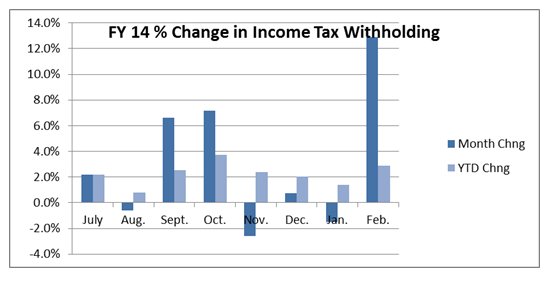
- A re-estimation of Connecticut's non-farm employment shows that the state added 18,400 jobs in 2013. Numbers released by the Department of Labor on March 27 indicated that the state lost 10,900 jobs in January 2014, but gained of 800 positions in February. Over the 12 months ending February, the state added 10,300 payroll positions. According to the Department of Labor, Connecticut has recovered 59,500 positions, or about half of the 119,100 seasonally adjusted total nonfarm jobs that were lost in the March 2008 - February 2010 employment recession.
- Nationally, over 90 percent of the recessionary job loss has been recovered. In January 129,000 jobs were added to U.S. non-farm payroll employment and in February an additional 175,000 jobs were gained.
- Connecticut's unemployment rate in February was 7.0 percent. This compares to a national rate of 6.7 percent.
- The largest year-over-year gains in February were in education and health services (6,200), leisure and hospitality (5,200) and construction (3,800); the largest losses were in government (-3,700) and manufacturing (-2,700).
- The charts below are a time series view of Connecticut employment and the unemployment rate.
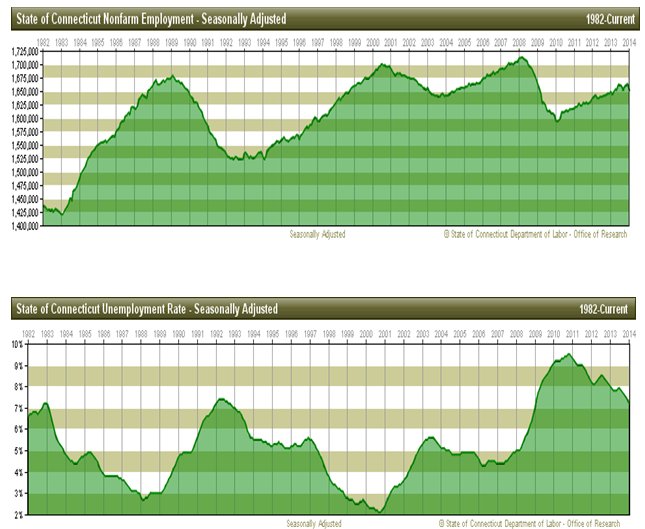
- Based on data released by the Bureau of Economic Analysis on March 25, personal income in Connecticut grew at a rate of 2.1 percent between 2012 and 2013 ranking the state 37th nationally in personal income growth. Net earnings increased 1.4 percent while dividends, interest and rent increased 3.7 percent. Personal income results for the 1st quarter of 2014 will be released on June 24.
-
The chart below shows the annual trend in Connecticut personal income. Because the state spending cap is based on the growth in personal income (or the rate of inflation if higher), the current trend places downward pressure on budgeted state spending. The cap does not apply to debt financed spending.
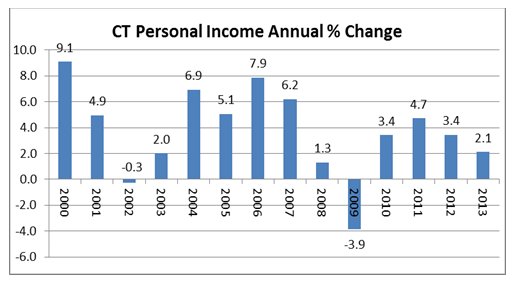
- The chart below shows the annual trend in Connecticut personal income. Because the state spending cap is based on the growth in personal income (or the rate of inflation if higher), the current trend places downward pressure on budgeted state spending. The cap does not apply to debt financed spending.
- Both average hourly earnings and average private sector weekly pay in Connecticut were relatively unchanged in February after falling 2 percent in January.
- The year-to-year change in the Consumer Price Index for All Urban Consumers (CPI-U, U.S. City Average) in February 2014 was 1.1 percent

- A strong housing market has lifted Connecticut's real estate conveyance tax receipts. Through February, total receipts are running about three-quarters above last year's level.
- Single-family home sales in Connecticut rose 2 percent in January, according to a new report from The Warren Group. This is the ninth consecutive month of home sale gains in the state. The 2-percent increase is below the 6-percent growth rate posted for the full 2013 calendar year, but weather played a role in slowing sales. Analysts are expecting pent up demand to accelerate spring sales.
- Home prices in Connecticut have remained flat on a year-to-year comparison over the past three-month period ending in January. The median home price in January was $230,000. In 2013, home prices in the state grew 8.3 percent. Increases in mortgage rates have contributed to a flattening in prices.
- Condominium sales in January fell by 7 percent from a year ago. This follows strong double-digit growth in 2013. Condo median prices also fell slightly in January. The median price decreased by less than half a percentage to $162,500 compared with $163,000 in January 2013.
- According to the National Association of Realtors, total U.S. existing home sales in February were down 7.1 percent from February of last year. The median home price was $189,000, which is 9.1 percent above last February's price level.
- Regionally, existing-home sales in the Northeast fell 12.7 percent below the February 2013 level. The median price in the Northeast was $237,800, up 1.5 percent from a year ago.
- The capital gains driven estimated payment portion of the income tax grew by almost 18 percent last fiscal year. This large increase was partially attributable to a capital gains tax change that went into effect at the end of 2012 and resulted in a roll-forward of taxable gains to Fiscal Year 2013. Absent the tax change, these roll-forward gains would have been realized in future years. The budget plan anticipated a softening of estimated payments in Fiscal Year 2014 based on the roll-forward activity. However, estimated payments through February of this fiscal year are up by almost 5 percent.
- The chart shows historical estimated payment activity through February from FY 07 to FY 14:
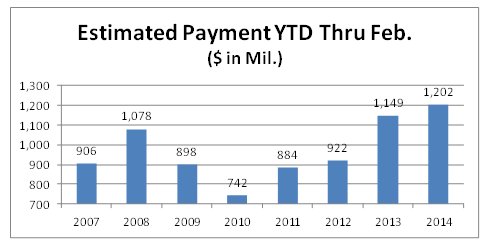
- At this writing the
Dow Jones Industrial Average has posted a 12-month gain of 12.75 percent;
however, on a calendar year to date basis the market has declined slightly:
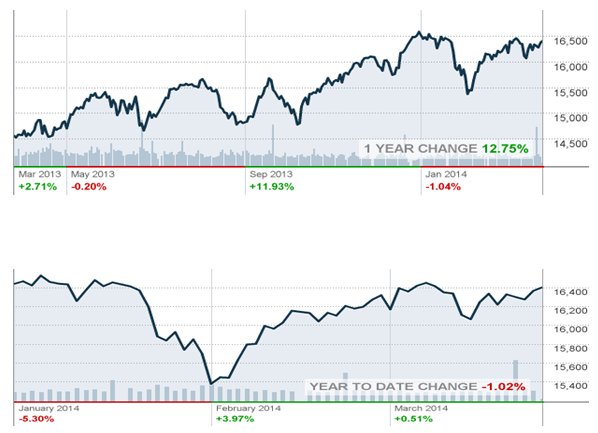
- Through February the sales tax was advancing at a 6.3-percent rate on a fiscal year-to-date basis. Receipts have been improving in the second half of the fiscal year.
- February advance retail sales were up a disappointing 1.5 percent from one year ago. In calendar year 2013, sales were 4.2 percent higher than in 2012. The slow growth in February is partially attributable to winter storms. Car sales, which had been posting gains in the range of 8 percent, grew by 2.2 percent. The strongest gains were once again in non-store retailers.
- According to the Federal Reserve, in January annualized consumer credit card debt contracted sharply. After growing 1.3 percent in 2013, revolving credit declined at an annualized rate of 0.3 percent in January. Non-revolving credit was up sharply increasing at an annualized 7.5 percent in January. This resulted in total consumer credit in January advancing by 5.3 percent. Total credit grew 6 percent in 2013.
BUSINESS AND ECONOMIC GROWTH
- Based on the March 27 release by the Bureau of Economic Analysis, real GDP increased at a rate 2.6 percent in the 4th quarter of 2013.Growth in the 3rd quarter was 4.1 percent quarter. The deceleration in real GDP in the fourth quarter reflected a deceleration in private inventory investment, a larger decrease in federal government spending, a downturn in residential fixed investment, and decelerations in state and local government spending and in nonresidential fixed investment that were partly offset by accelerations in exports and in personal consumption expenditures and a deceleration in imports.
- Corporate profits posted growth of 6 percent from one year ago in the 4th quarter of 2013. Profits grew by better than 7 percent in both 2011 and 2012. Profit gains softened in 2013 growing by 4.6 percent.
- The Department of Labor's General Drift Indicators are composite measures of the four-quarter change in three coincident (Connecticut Manufacturing Production Index, nonfarm employment, and real personal income) and four leading (housing permits, manufacturing average weekly hours, Hartford help-wanted advertising, and initial unemployment claims) economic variables, and are indexed so 1986 = 100.
